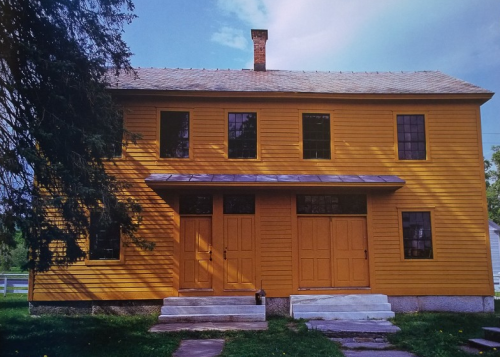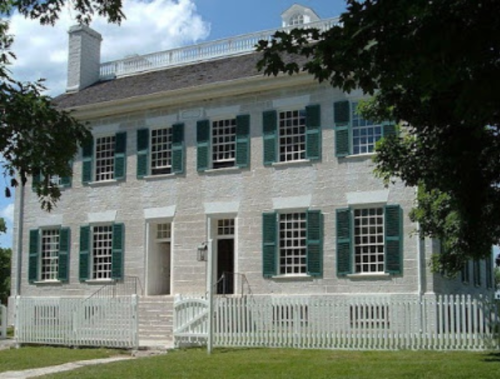The Shakers: Early American Minimalism
Visit my NEW site Alexandra Eidenschenk Designs

I have long admired Shaker architecture and we’re lucky here in the Berkshires to have two historical Shaker centers – in Tyringham and Hancock, MA – in which to study it. In 1774, Mother Ann Lee left England for the Albany, NY area to start a religious movement in America based on honesty, humility, charity and simplicity. By the 1840’s this group had reached its pinnacle but then had almost died out by about 1875. Given that the Shakers only flourished for about 100 years, it’s incredible to know how many books have been published on their lives, inventions, design aesthetic and craftsmanship. In many ways, they were ahead of their time.
I’m planning to build a house within the next couple of years and subsequent blogs will focus on the lengthy design process around my love for early American architecture and artisanship. This article specifically is a celebration of the Shakers, who have inspired many ideas and innovations in my architectural and interior design strategy — simplicity, symmetry, light, air flow, craftsmanship and a marriage of form and function.
Above all, Shakers sought freedom from earthly possessions and heavenly purity, so restraint and minimalism were key principals of their architecture and design practices. Their buildings, rooted in Georgian and Dutch colonial architecture from New England and the mid-Atlantic states, were unadorned, mostly symmetrical and quietly elegant. In their written laws, it stated that “beadings, moldings and cornices which are merely for fancy may not be made by Believers.” 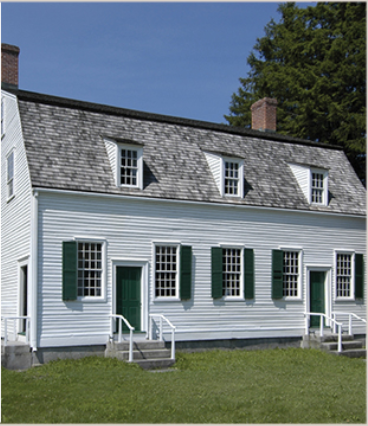
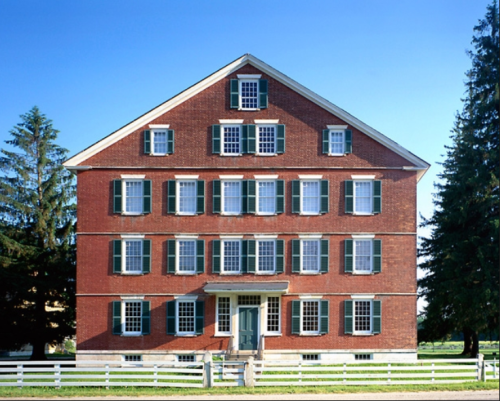 Exterior trim work was minimal and often painted the same color as the clapboard so as not to stand out. Buildings built out of brick and stone generally had more decoration but were still reserved.
Exterior trim work was minimal and often painted the same color as the clapboard so as not to stand out. Buildings built out of brick and stone generally had more decoration but were still reserved.
The Shakers believed that “cleanliness is next to godliness.” Furnishings were kept to a minimum for the sake of simplicity and order, and art was considered useless. Bare white plaster walls in interior spaces made it hard to hide dirt and and pegboards lined most rooms to keep household items off the floor for easy cleaning. 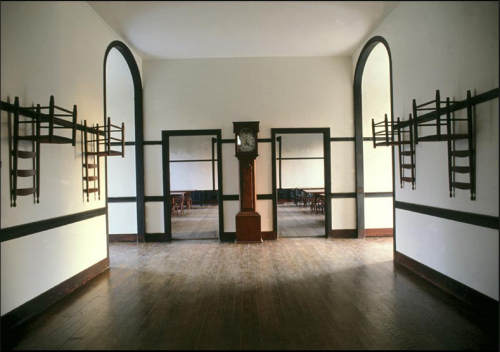 Ladder back chairs were hung upside down to keep the woven seats from gathering dust. The Shakers actually invented the flat broom, which revolutionized cleaning (they made a fortune selling these brooms to non-believers), and they devised an ingenious system of hanging laundry in library-like pull out shelves. Their clean, clutter-free environment made work easier and left their minds open to pursue a rich spiritual life.
Ladder back chairs were hung upside down to keep the woven seats from gathering dust. The Shakers actually invented the flat broom, which revolutionized cleaning (they made a fortune selling these brooms to non-believers), and they devised an ingenious system of hanging laundry in library-like pull out shelves. Their clean, clutter-free environment made work easier and left their minds open to pursue a rich spiritual life.
The Shakers are perhaps best known for their exquisite cabinetry which was built flush to the wall from the floor to the ceiling, often located under eaves and staircases. 
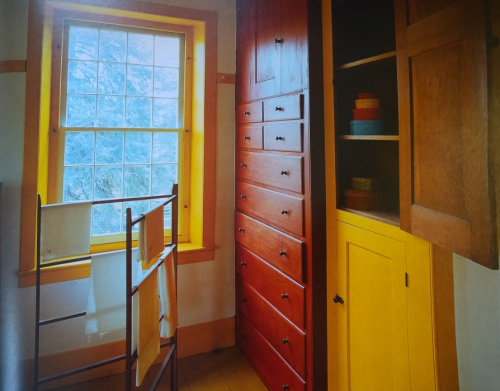 This left no horizontal surfaces to dust and everything could be neatly stored away giving every household item its proper place. Drawers were bigger at the bottom, getting smaller on the way up, to make it useful for storing large heavy items closer to the floor. This is also pleasing to the eye – a perfect marriage of form and function.
This left no horizontal surfaces to dust and everything could be neatly stored away giving every household item its proper place. Drawers were bigger at the bottom, getting smaller on the way up, to make it useful for storing large heavy items closer to the floor. This is also pleasing to the eye – a perfect marriage of form and function.
Light was considered divine and the Shakers were masters at maximizing the beauty of natural light to enhance everyday tasks and bring a sense of joy to their lives. 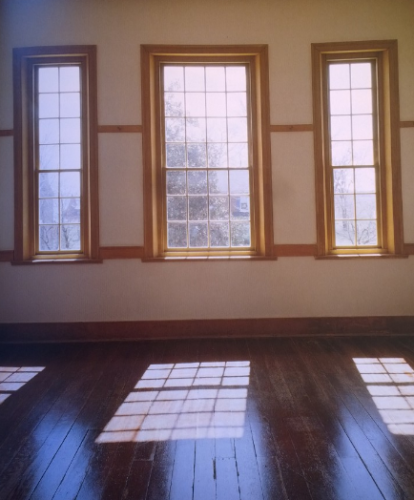
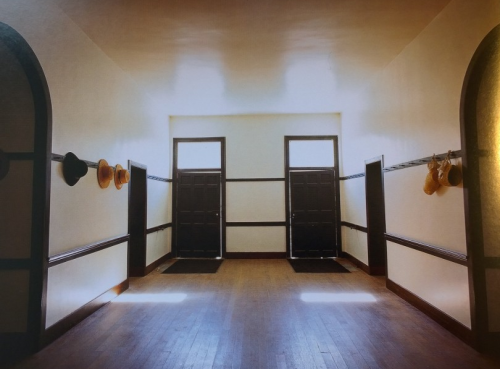 Each Shaker building contained many windows with large openings that were perfectly placed to capture light throughout the day and to promote air flow; in fact, the window to wall surface ratio was much higher on Shaker buildings than on other period buildings (this concept is called fenestration). Ingeniously, the longer side of a Shaker building was generally oriented east-west to best capture dawn and sunset light and it is for this reason that most of their buildings seem to have an inner glow.
Each Shaker building contained many windows with large openings that were perfectly placed to capture light throughout the day and to promote air flow; in fact, the window to wall surface ratio was much higher on Shaker buildings than on other period buildings (this concept is called fenestration). Ingeniously, the longer side of a Shaker building was generally oriented east-west to best capture dawn and sunset light and it is for this reason that most of their buildings seem to have an inner glow. 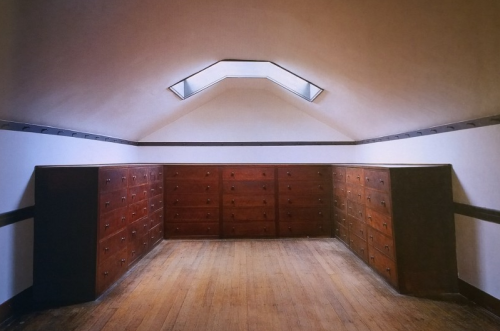
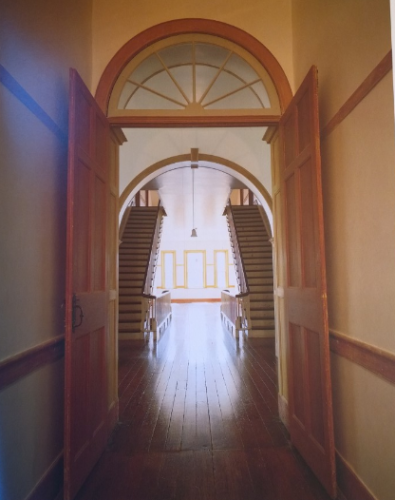 Interior windows and transom lights over doorways brought exterior light farther inside. Deep window wells, angled from outside inward, brought light inside from three directions. Dormer windows in the roof line were abundant, and it was the Shakers who embraced the skylight concept to bring much-needed light into dark attic spaces. To this day, a walk through a Shaker building is a spiritual journey of harmony and tranquility.
Interior windows and transom lights over doorways brought exterior light farther inside. Deep window wells, angled from outside inward, brought light inside from three directions. Dormer windows in the roof line were abundant, and it was the Shakers who embraced the skylight concept to bring much-needed light into dark attic spaces. To this day, a walk through a Shaker building is a spiritual journey of harmony and tranquility.
The use of color in Shaker architecture exemplified their reverence for god and nature. White paint was considered heavenly because it reflects light, it was reserved for the exterior of meetings houses and for interior spaces. Classic Shaker colors like mustard, blue and barn red, were created from materials in nature and were designed to contrast with the white, therefore highlighting it. Even the semi-transparent sheen added to trim paint and flooring helped to bounce the light and highlight the divinity in the woodwork. The Shakers brilliantly managed to achieve a calm beauty with their simple design practices.
As “the eye is the window to the soul, the window is the eye of a building.” Windows become the focus of attention within any room, and the Shakers designed them brilliantly. 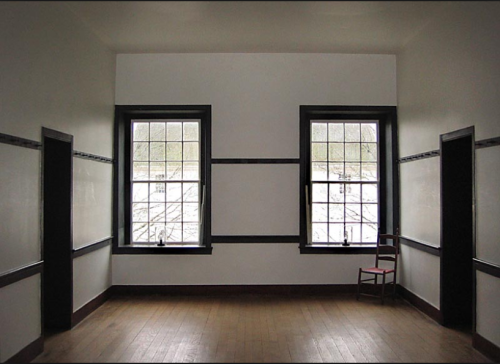
 They believed that windows could perfectly frame the outdoor world in celebration and thus positioned them at the end of a hallway or at the top of a staircase as a sort of “reveal.” Nowadays people favor casements without muntins (the vertical and horizontal panes between glass panels) because they think that the muntins obstruct the view. But what could me more entrancing than a beautiful view framed by a beautiful window?
They believed that windows could perfectly frame the outdoor world in celebration and thus positioned them at the end of a hallway or at the top of a staircase as a sort of “reveal.” Nowadays people favor casements without muntins (the vertical and horizontal panes between glass panels) because they think that the muntins obstruct the view. But what could me more entrancing than a beautiful view framed by a beautiful window?
Like the Shakers, I’m a minimalist – although not to the point of asceticism! I firmly believe that where we live is an expression of who we are inside. A chaotic person will inevitably have a cluttered home (and car and wallet…) while a centered person will have a clean, calm home filled with light and love. For me, my home is where I restore my energy and refresh my creative spirit – it’s my “soft place to land” – and I have spent years studying design and building practices that result in incredible spaces. The Shakers got it mostly right. You will see that I have taken much inspiration from them in designing my own “new old house,” the subject of many future blogs.

